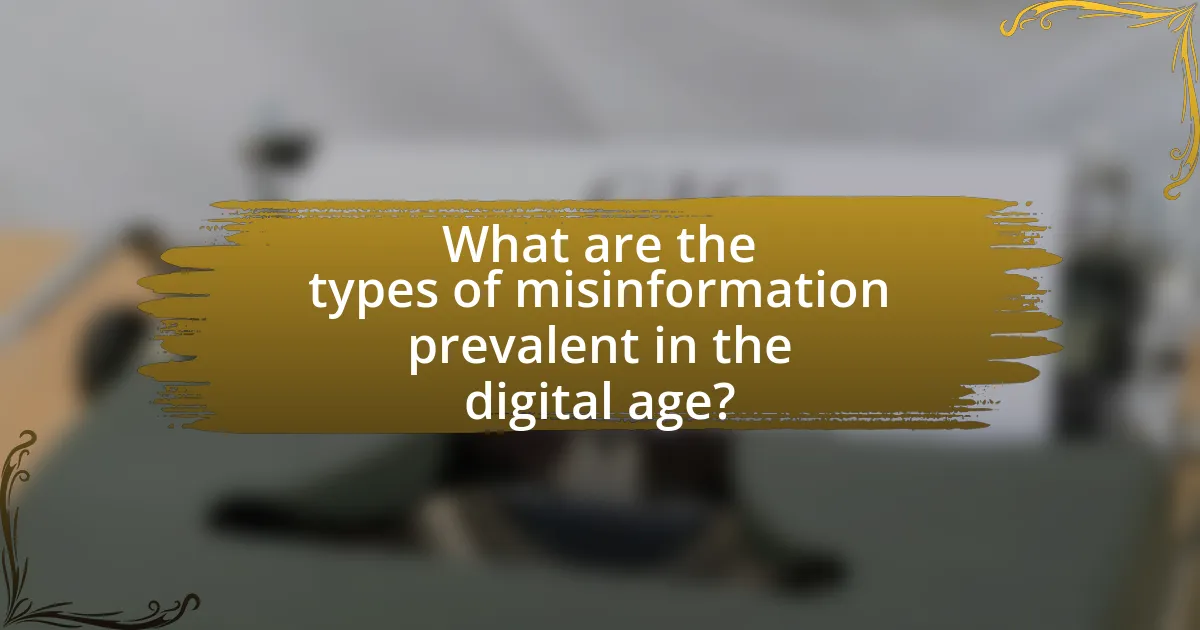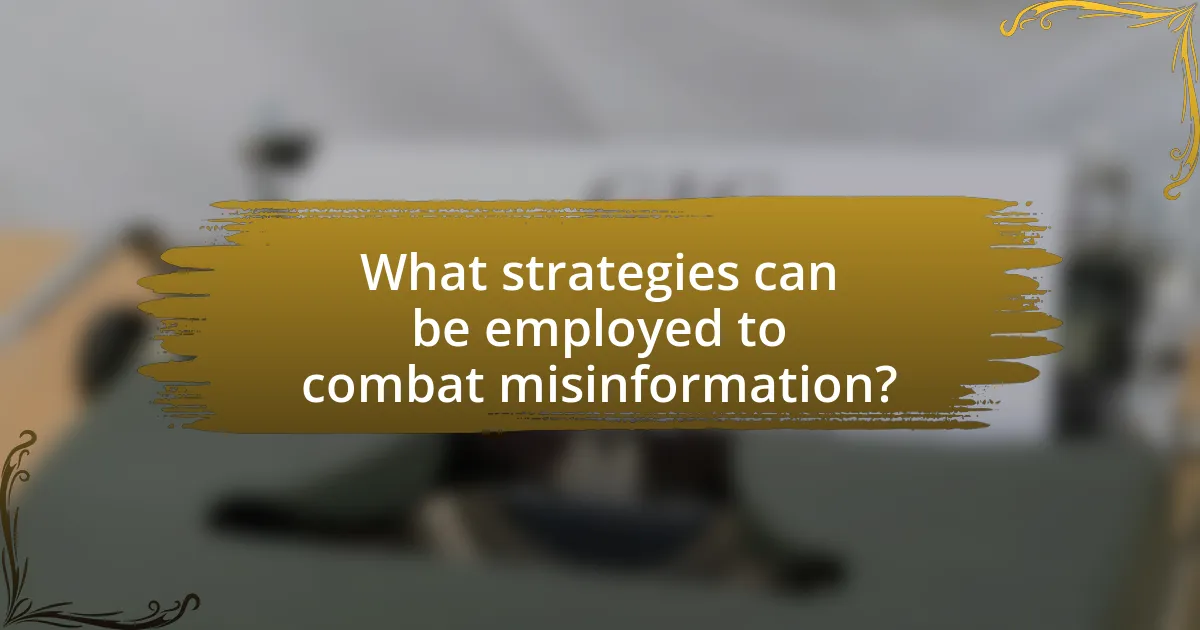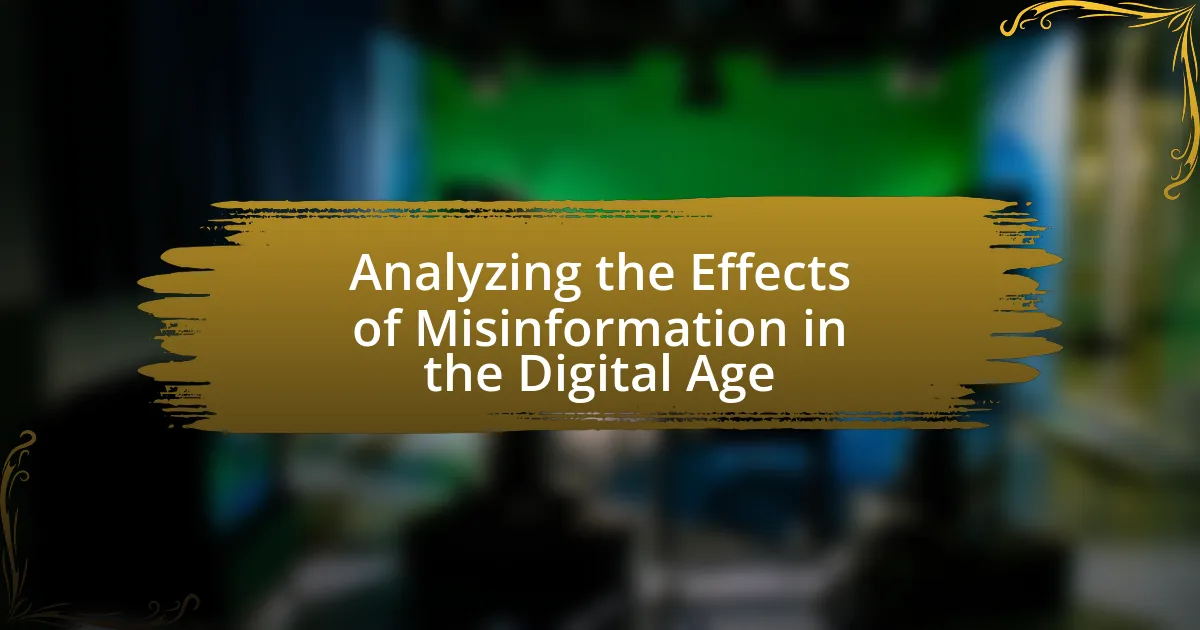Misinformation in the digital age refers to false or misleading information spread through digital platforms, often without malicious intent. This article analyzes the mechanisms of misinformation dissemination, particularly through social media algorithms that prioritize engagement over accuracy, leading to rapid viral spread. It explores the significant impact of misinformation on public opinion, democratic processes, and societal trust, highlighting various types such as fake news and conspiracy theories. Additionally, the article discusses the motivations behind creating and sharing misinformation, the role of user behaviors, and effective strategies for combating misinformation, including fact-checking and media literacy education.

What is Misinformation in the Digital Age?
Misinformation in the digital age refers to false or misleading information disseminated through digital platforms, often without malicious intent. This phenomenon is exacerbated by the rapid spread of information via social media, where users can share content widely and quickly, leading to the viral propagation of inaccuracies. According to a study by the MIT Media Lab, false news stories are 70% more likely to be retweeted than true stories, highlighting the significant impact of misinformation on public perception and discourse.
How does misinformation spread in digital platforms?
Misinformation spreads in digital platforms primarily through social media, where algorithms prioritize engagement over accuracy. These platforms facilitate rapid sharing and amplification of false information, often driven by sensationalism and emotional appeal, which captures user attention. A study by Vosoughi, Roy, and Aral in 2018 found that false news spreads significantly faster and reaches more people than true news, highlighting the role of user interactions and network dynamics in the dissemination process. Additionally, the lack of effective fact-checking mechanisms and the tendency for users to share content without verification further exacerbate the spread of misinformation.
What role do social media algorithms play in the dissemination of misinformation?
Social media algorithms significantly contribute to the dissemination of misinformation by prioritizing content that generates high engagement, often regardless of its accuracy. These algorithms analyze user interactions, such as likes, shares, and comments, to promote posts that are likely to capture attention, which can lead to the viral spread of false information. Research indicates that false news spreads more rapidly on social media platforms than true news, with a study published in Science in 2018 showing that false information is 70% more likely to be retweeted than true information. This engagement-driven model incentivizes the creation and sharing of sensational or misleading content, thereby amplifying misinformation in the digital landscape.
How do user behaviors contribute to the spread of misinformation?
User behaviors significantly contribute to the spread of misinformation through mechanisms such as sharing, liking, and commenting on content without verifying its accuracy. When individuals engage with sensational or emotionally charged posts, they amplify the reach of misleading information, as algorithms prioritize such interactions, leading to wider dissemination. Research indicates that misinformation spreads faster on social media platforms than factual information, with a study by Vosoughi, Roy, and Aral (2018) published in Science revealing that false news stories are 70% more likely to be retweeted than true ones. This behavior creates an environment where misinformation can thrive, as users often prioritize engagement over accuracy.
Why is misinformation a significant issue today?
Misinformation is a significant issue today because it undermines public trust, distorts reality, and influences decision-making processes. The rapid spread of false information, particularly through social media platforms, has been shown to affect elections, public health responses, and societal cohesion. For instance, a study by the Pew Research Center found that 64% of Americans believe that misinformation has caused confusion about basic facts, particularly during the COVID-19 pandemic. This confusion can lead to harmful behaviors, such as vaccine hesitancy, which has real-world consequences on public health.
What are the potential consequences of misinformation on public opinion?
Misinformation can significantly distort public opinion, leading to polarization and mistrust in institutions. When individuals are exposed to false information, they may form inaccurate beliefs that influence their attitudes and behaviors, often resulting in divided communities. Research indicates that misinformation can sway electoral outcomes; for instance, a study by the Pew Research Center found that 64% of Americans believe fabricated news stories cause confusion about the basic facts of current events. Furthermore, misinformation can undermine public health initiatives, as seen during the COVID-19 pandemic, where false claims about vaccines led to hesitancy and resistance among populations. These consequences illustrate the profound impact misinformation has on shaping societal views and actions.
How does misinformation impact democratic processes?
Misinformation undermines democratic processes by distorting public perception and influencing voter behavior. It creates confusion and distrust among citizens, leading to polarization and the erosion of informed decision-making. For instance, a study by the Pew Research Center found that 64% of Americans believe fabricated news stories cause significant confusion about the basic facts of current events. This confusion can result in voters making choices based on false information, ultimately affecting election outcomes and policy decisions.

What are the types of misinformation prevalent in the digital age?
The types of misinformation prevalent in the digital age include fake news, disinformation, malinformation, and conspiracy theories. Fake news refers to fabricated stories presented as news, often designed to mislead readers. Disinformation involves the deliberate spread of false information to manipulate public opinion or obscure the truth, as seen in various political campaigns. Malinformation is based on factual information but is shared with the intent to cause harm, such as revealing private information. Conspiracy theories are narratives that attribute significant events to secret plots, often lacking credible evidence. According to a 2020 study by the Pew Research Center, 64% of Americans believe that misinformation has caused confusion about basic facts, highlighting the widespread impact of these misinformation types.
How do different forms of misinformation manifest online?
Different forms of misinformation manifest online through various channels, including social media, websites, and messaging apps. Social media platforms often facilitate the rapid spread of false information due to their algorithms prioritizing engagement over accuracy, leading to viral misinformation campaigns. Websites may host fabricated news articles or misleading headlines designed to attract clicks, while messaging apps can propagate rumors and hoaxes through private sharing among users. Research indicates that misinformation spreads six times faster than factual information on platforms like Twitter, highlighting the significant impact of these channels in disseminating false narratives.
What distinguishes fake news from satire and misinformation?
Fake news is characterized by the intentional dissemination of false information presented as news, aiming to mislead the audience, while satire uses humor, irony, or exaggeration to critique or comment on real events without the intent to deceive. Misinformation, on the other hand, refers to false or misleading information spread without malicious intent, often due to misunderstanding or lack of knowledge. For example, a study by Lewandowsky et al. (2012) in “Psychological Science in the Public Interest” highlights that fake news is crafted to manipulate beliefs, whereas satire and misinformation may not have the same objective of deception.
How do conspiracy theories proliferate in digital spaces?
Conspiracy theories proliferate in digital spaces primarily through social media platforms and online forums that facilitate rapid information sharing. These platforms enable users to disseminate unverified claims quickly, often leading to viral spread due to algorithms that prioritize engagement over accuracy. Research indicates that misinformation spreads six times faster than factual information on Twitter, highlighting the effectiveness of these digital channels in amplifying conspiracy theories. Additionally, echo chambers and confirmation bias within online communities reinforce these theories, as individuals seek out and share content that aligns with their pre-existing beliefs, further entrenching misinformation.
What are the motivations behind creating and sharing misinformation?
The motivations behind creating and sharing misinformation include political gain, financial profit, social influence, and psychological gratification. Political actors often disseminate false information to manipulate public opinion or discredit opponents, as seen in various election cycles where misinformation campaigns have swayed voter perceptions. Financially, individuals or organizations may spread misinformation to generate clicks and ad revenue, exemplified by clickbait articles that prioritize sensationalism over accuracy. Socially, people may share misinformation to align with group beliefs or enhance their status within a community, reflecting a desire for acceptance or validation. Psychologically, the act of sharing misinformation can provide a sense of power or control, fulfilling emotional needs. These motivations are supported by studies indicating that misinformation can significantly impact public behavior and attitudes, as evidenced by research from the Pew Research Center, which highlights the role of social media in amplifying false narratives.
How do political agendas influence the spread of misinformation?
Political agendas significantly influence the spread of misinformation by shaping narratives that align with specific ideological goals. Political entities often disseminate misleading information to manipulate public perception, rally support, or discredit opponents. For instance, during the 2016 U.S. presidential election, various political groups utilized social media platforms to propagate false information that favored their candidates, demonstrating how targeted misinformation can sway voter opinions and alter electoral outcomes. Research by the Pew Research Center indicates that 64% of Americans believe fabricated news stories cause confusion about the basic facts of current events, highlighting the effectiveness of politically motivated misinformation in distorting public understanding.
What financial incentives drive the creation of misleading content?
Financial incentives that drive the creation of misleading content include advertising revenue, affiliate marketing commissions, and increased website traffic. Content creators often prioritize sensationalism or false narratives to attract clicks, as higher engagement translates to greater ad revenue. For instance, a study by the Pew Research Center found that misleading headlines can generate significantly more shares and views compared to factual reporting, leading to increased financial gain for the creators. Additionally, platforms like Facebook and Google reward content that garners high engagement, further incentivizing the production of misleading information for profit.

What strategies can be employed to combat misinformation?
To combat misinformation, strategies such as fact-checking, media literacy education, and the use of technology to identify false information can be employed. Fact-checking organizations, like Snopes and FactCheck.org, verify claims and provide accurate information, helping to debunk false narratives. Media literacy education equips individuals with critical thinking skills to assess the credibility of sources and discern factual content from misinformation. Additionally, technology solutions, including algorithms and AI tools, can detect and flag misleading content on social media platforms, reducing its spread. These strategies collectively enhance public awareness and promote informed decision-making in the digital age.
How can individuals identify and verify information sources?
Individuals can identify and verify information sources by assessing the credibility, accuracy, and reliability of the content. To do this, they should check the author’s qualifications, the publication’s reputation, and the presence of citations or references to reputable sources. For instance, a study by the Pew Research Center found that 64% of Americans believe that misinformation is a major problem, highlighting the need for critical evaluation of sources. Additionally, cross-referencing information with multiple trusted outlets can further validate the accuracy of the claims made.
What tools and resources are available for fact-checking?
Various tools and resources are available for fact-checking, including websites like Snopes, FactCheck.org, and PolitiFact. These platforms provide verified information and analyses of claims made in media and public discourse. Additionally, tools such as Google Fact Check Explorer allow users to search for fact-checked articles related to specific topics or claims. The International Fact-Checking Network (IFCN) offers a directory of fact-checking organizations worldwide, promoting transparency and collaboration among fact-checkers. These resources are essential in combating misinformation by providing reliable verification of facts.
How can critical thinking skills help in discerning misinformation?
Critical thinking skills enhance the ability to discern misinformation by enabling individuals to analyze, evaluate, and synthesize information critically. These skills allow a person to question the credibility of sources, assess the validity of arguments, and identify logical fallacies. For instance, a study published in the journal “Science” by Lewandowsky et al. (2012) highlights that individuals with strong critical thinking abilities are better equipped to recognize misleading information and resist cognitive biases that can distort judgment. This capacity to scrutinize information leads to more informed decision-making and a greater likelihood of rejecting false claims.
What role do organizations and platforms play in addressing misinformation?
Organizations and platforms play a crucial role in addressing misinformation by implementing policies, technologies, and educational initiatives aimed at identifying and mitigating false information. For instance, social media platforms like Facebook and Twitter employ algorithms and fact-checking partnerships to flag or remove misleading content, thereby reducing its spread. Research from the Pew Research Center indicates that 64% of Americans believe social media companies should take more responsibility for preventing misinformation. Additionally, organizations such as the International Fact-Checking Network promote best practices among fact-checkers and provide resources to help users discern credible information. These efforts collectively contribute to a more informed public and help combat the negative impacts of misinformation in the digital age.
How effective are content moderation policies in reducing misinformation?
Content moderation policies are effective in reducing misinformation, as evidenced by various studies showing a decrease in the spread of false information on platforms that implement these measures. For instance, a study by the Pew Research Center found that 64% of Americans believe social media companies should take steps to limit misinformation. Additionally, platforms that employ automated fact-checking and user reporting mechanisms have seen a significant reduction in the visibility of misleading content. Research published in the journal “Nature” indicated that platforms with robust moderation policies can reduce the spread of false narratives by up to 70%. These findings demonstrate that effective content moderation can significantly mitigate the impact of misinformation in digital spaces.
What initiatives have been successful in combating misinformation online?
Successful initiatives in combating misinformation online include fact-checking organizations, social media platform policies, and educational programs. Fact-checking organizations like Snopes and FactCheck.org have effectively debunked false claims, providing evidence-based corrections that enhance public awareness. Social media platforms, such as Facebook and Twitter, have implemented measures like labeling false information and reducing the visibility of misleading posts, which has been shown to decrease the spread of misinformation. Additionally, educational programs aimed at improving digital literacy equip users with skills to critically evaluate online content, leading to more informed consumption of information. These initiatives collectively contribute to a more informed public and a reduction in the impact of misinformation.
What best practices can individuals adopt to minimize the impact of misinformation?
Individuals can minimize the impact of misinformation by critically evaluating sources before sharing information. This involves checking the credibility of the source, looking for corroborating evidence from reputable outlets, and being aware of potential biases. Research indicates that individuals who engage in fact-checking and source verification are less likely to propagate false information, as demonstrated by a study from the Pew Research Center, which found that 64% of Americans believe that misinformation is a major problem in society. By adopting these practices, individuals can significantly reduce the spread and influence of misinformation in the digital age.

Leave a Reply